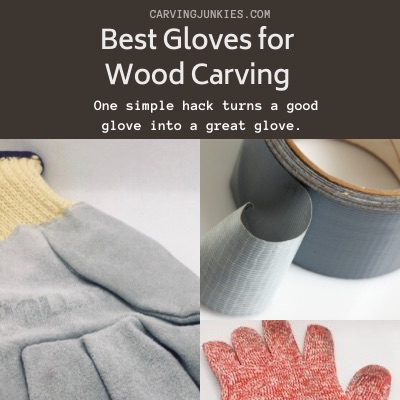- Home
- How to hand carve wood
- Best gloves for wood carving
The very best gloves for wood carving
Learn how to get the ultimate protection.
The best gloves for wood carving are those that allow you to carve safely, comfortably, and easily without losing any blood!
At some point, every wood carver will be "kissed by a knife." Even expert carvers can slip up every now and then.
Most of the time, you won't even see it coming.
Better to be safe than sorry
When we were first learning to how to wood carve, we were very lucky to experience only a few superficial cuts.
But it was enough to convince us that we definitely needed full-time protection.
So we searched for (and found) what we think are the best gloves for wood carving.
Now, wearing a glove is just a normal part of our carving routine and we can't imagine working without them.
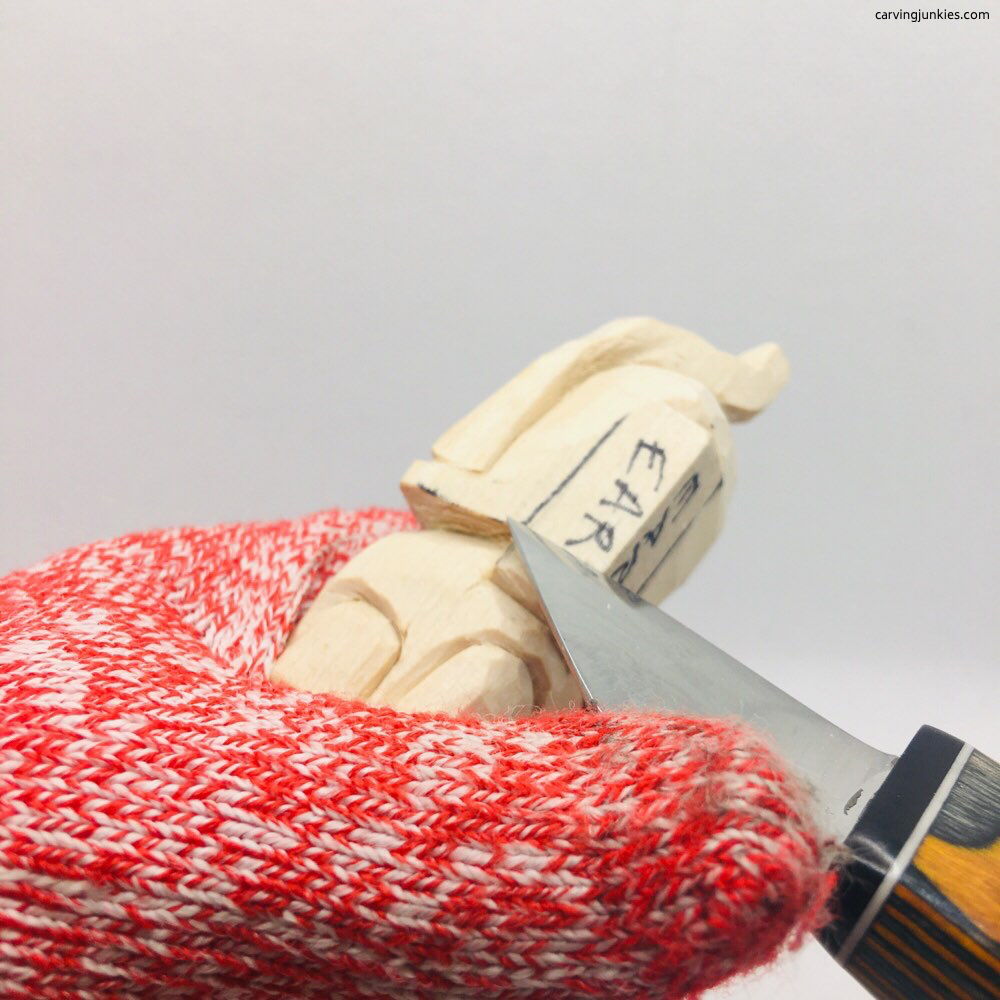 Knives can cut wood and skin
Knives can cut wood and skinKevlar gloves are good, but not the best gloves for wood carving
A lot of carvers simply use a Kevlar cut-resistant glove on their non-carving hand. They are light and not too expensive. But if you are "kissed" by the sharp point of a knife, you're gonna shed blood.
It happened to us and it wasn't pretty. If your slip is deep enough, you may even need stitches.
Standard Kevlar gloves are also not the best gloves for wood carving because they do not protect your hands from slips with gouges, which is something to consider, too.
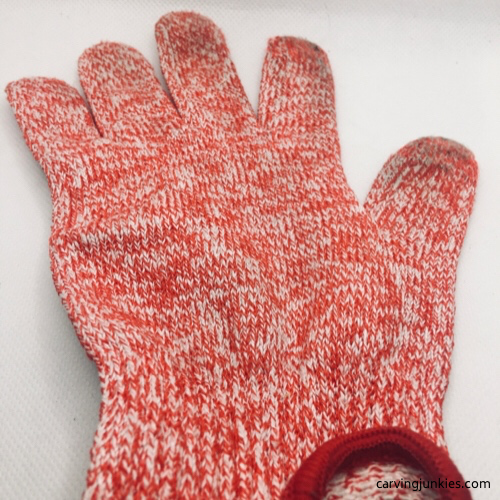 Regular Kevlar glove
Regular Kevlar gloveLeather-lined Kevlar gloves are closer to the best gloves for wood carving
While no glove can claim to be 100% failsafe, leather-lined Kevlar gloves provide extra protection from knife-point jabs and cuts.
They also provide added protection for slips when using gouges, which can cause serious damage if you slip up. The extra layer of leather goes a long way to help protect your hands. We can say this from experience.
The down side is that these gloves are about twice as expensive and they are a bit bulky.
The upside is that they provide a lot of cushioning that makes carving for hours quite comfortable.
Is the difference that noticeable?
Since our leather-lined Kevlar gloves get pretty ratty, we use a regular Kevlar glove when taking pictures for our tutorials.
Sometimes we forget to switch back to the leather-lined Kevlar glove. Carving is so uncomfortable! We have come to appreciate that the bulkiness serves a good purpose.
Of course, it's a matter of personal preference. But now that we are used to the bulkier, cushioned glove, we cannot carve without it.
But are they the very best gloves for wood carving?
They are with one simple add-on.
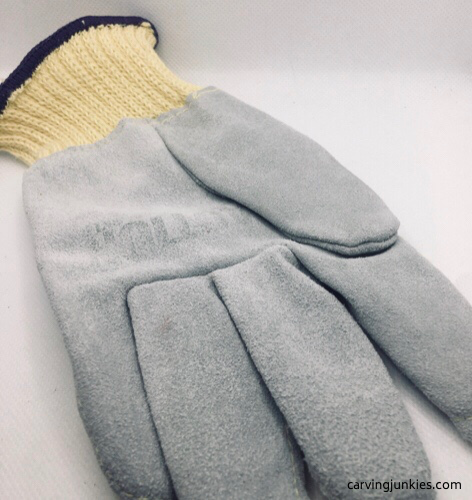 Leather-lined Kevlar glove
Leather-lined Kevlar gloveThe best gloves for wood carving are duct-taped, leather-lined Kevlar gloves
We have learned from experience that wrapping a leather-lined Kevlar glove with duct tape protects fingers even further and extends the life of the glove (the knife cuts the tape and not the glove).
Over time, the glove looks like crap, but dang, it sure protects well!
With this simple hack, duct-taped, leather-lined Kevlar gloves are definitely the best gloves for wood carving.
Yes... they are super bulky, but easy to get used to, as long as you stick with them. They will also soften up fairly quickly as they are a bit stiff at first.
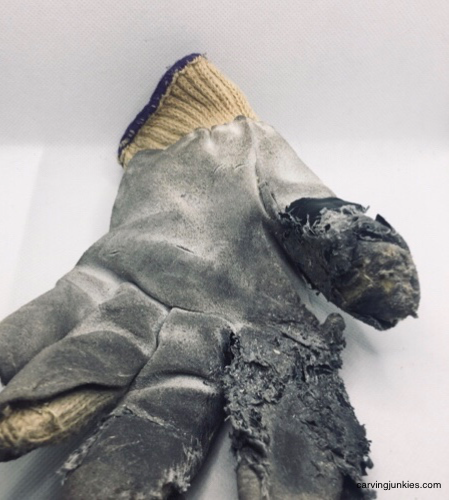 This old friend still has many miles to go
This old friend still has many miles to goOne glove or two?
We always use the leather-lined Kevlar glove on our non-carving hand. Sometimes we will wrap the thumb of our carving hand with tape (hockey stick tape or vet tape works good) if we know we're going to use a lot of pull cuts.
Some carvers just use tape on both hands, but we feel it would be flirting with potential disaster.
When we are stropping a knife, we wear our reinforced glove and a standard Kevlar glove on the hand that holds the knife.
Why, you may ask?
Imagine getting a paper cut on steroids. That only had to happen once for us to cry "uncle" and always wear the glove on our carving hand for extra protection while stropping.
Gloves only protect when you wear them
The best gloves for wood carving aren't much help if you don't wear them every time you carve. You need to make wearing gloves a (good) habit.
We have a few other rules for ourselves that have served us well (no stitches to date), including:
- Whenever picking up a knife, the glove goes on: When getting ready to call it a day (and taking the glove off), it is so easy to think "I'm just gonna make this one last cut and I'll be okay..." The most dangerous time to carve is anytime you are not protected.
- If we think a cut may pose a safety risk, we do not make it. Taking chances are great for things like buying lottery tickets, but it isn't worth the risk when you are working with super sharp instruments. It is better to take 10 seconds to figure out how you can make the cut more safely than risk an accident.
- While this page is about gloves, if we're going to do a lot of gouge work (or roughing out a piece), we use a vise. Using two hands, securing your carving, and not carving toward your hand or body, should be safer.
Where can you get the best gloves for wood carving?
Our source for leather-lined Kevlar gloves is The Carving Glove Guy.
Once you find what you want, shoot over an email and and they will call you to take your order over the phone. They do not process credit cards through their website.
They are great to work with and can help you determine what size is best for you. They may even send you a free gift with your order.
Tip: Gloves are sold separately (not as a pair). Check the codes carefully to be sure you are ordering the right glove for your non-carving hand.
Are leather-lined Kevlar gloves worth the extra cost?
We think so. In fact, we had the (not so) bright idea to buy cheap leather gloves at the flea market, remove the leather with a seam ripper, and re-sew it onto regular Kevlar gloves.
Well, that was a disaster. Turns out making those gloves are a lot harder than it looks!
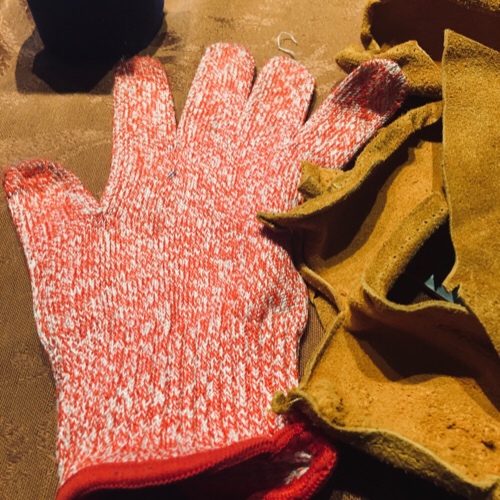 Easy to buy, hard to make
Easy to buy, hard to makeWhat about buying regular Kevlar gloves?
Amazon is a great place to shop for different Kevlar gloves. There are many different styles and some have rubber grippy dots that help secure the wood in your hand.
Some gloves may have a higher cut-resistant grade level of protection, and there are different standards for US and European products.
- In the US, 9 is the highest grade level.
- In Europe, you may see the EN388 standard used, which uses two measures (the Coup Test and TDM-100 Test). There are 6 tests used. All have a rating of 1-4, except for the cut (Coup Test), which is rated 1-5.
Wouldn't 100% Kevlar be the best gloves for wood carving?
We thought these might be a great idea. Unfortunately these chainmail gloves (think medieval days) have holes and will not protect against knife punctures.
They are also expensive (even more costly than the leather-lined Kevlar gloves).
What about thumb guards?
Some carvers really like using thumb guards. We find they tend to fall off easily. If that happens, tape may be a better bet.
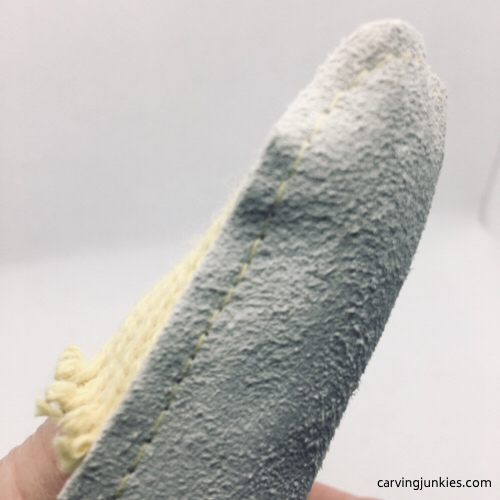 Thumb guards work for some
Thumb guards work for someAny additional safety tips?
No matter what type of glove you use, it is always safer to make all your cuts away from your hands (and your body). You should also always protect your lap.
We like using a wooden vegetable box on the lap, but a wood carving board works well, too.
Summary of the best gloves for wood carving
- Knives and gouges are sharp instruments and accidents can happen.
- Gloves are a proactive way to avoid problems before they occur.
- For the ultimate in protection, duct-taped, leather-lined Kevlar gloves are the best gloves for wood carving.
- Safe carving is happy carving... have fun!
Get 50 Wood Carving & Painting Tips when you join our FREE Covered in Chips club.
Share this page
carvingjunkies.com never sells your personal information.
This site uses cookies for its operation and to enhance your experience. As an Amazon Associate and Focuser Carving affiliate we earn from qualifying purchases.
Home | About Us | Privacy Policy | Terms of Use | Contact | Sitemap
